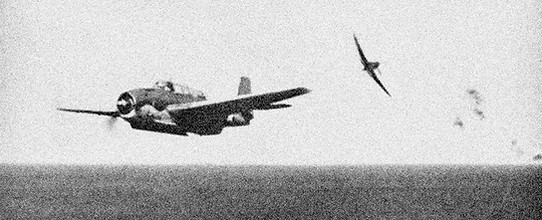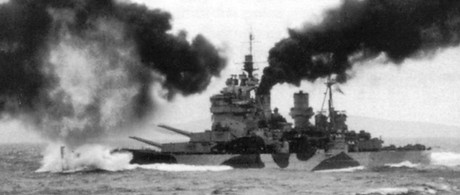

Left: Olafur Thors, Prime Minister of Iceland, 21 October 1944 – 4 February 1947. Above: A Boeing JRB aircraft departing from Portland, Maine to take part in Operation Ragtime. Below left: Soldiers of the 82nd Airborne Division fighting in the suburbs of Reykjavik. Below right: A damaged JRB aircraft in Prince Christian Sound with the USS Tambalier in attendance.



Left: American Consolidated B24 'Liberator' bombers on their way to attack the Kriegsmarine fleet base at Trondheim in Norway, 19th July 1945. Losses were heavy. Below: A German Messerschmitt Me 364 bomber at the German air base at Lajes in the Azores. The aircraft is about to set out on a raid of Philadelphia, 29th June 1945 and has the outer jetisonable undercarriage units in place.



Above left: The Italian battleship Roma, on fire and sinking, 27th July 1945, during the Battle of Finisterre. Above right: The American aircraft carrier USS Alliance after being struck by a submarine launched torpedo during the same battle.





Top left and centre: Admiral Otto Schniewind of the Kriegsmarine and Admiral Royal Ingersol of the USN, the men who led the opposing fleets at the Battle of the Celtic Sea. Top right: Junkers Ju 187 dive bombers from the German aircraft carrier Falke. Above left: The German carrier Strasser was hit multiple times by American air strikes and sunk. Above right: Grumman F6F fighters landing aboard the USS Enterprise during the Celtic Sea action. Below left: A Heinkel He 100 fighter breaks off an attack on a Grumman TBF torpedo bomber. Below right: Aquila, on fire. She sustained severe damage but got away.




Above left. USS Essex moored at Norfolk and ready to enter dry dock after the Battle of the Celtic Sea. She is riding high out of the water because her air group has departed and her stores and ammunition are low. Above right: A Caproni Ca. 336 torpedo bomber is hit while running on to an American battleship, in this case the Indiana.




Above left: General Alan Brooke, Chief of the Imperial General Staff of the British Army 1943-1945. Centre left: Sir Oliver Lyttelton, Britain’s Minister of State for the Far East 1941-45. Centre right: General Arthur Percival, architect and organiser of the defences of British territories in the Far East 1941-1944. Later in the war, he was one of the men who created the 'Vambrace' Plan for the defence of the United Kingdom. Above right: Field Marshal Phibun Songkram, Prime Minister of Thailand 1941-1944. In the interbellum, Songkram had the unenviable task of choosing between the aggressive Japanese and the apparently vacillating British.





Top left: A Grumman F6F 'Hellcat' fighter of the US Navy. Top right: A Mitsubishi A7M 'Reppu' (Hurricane) fighter of the Imperial Japanese Navy. Given the code-name 'Sam,' the performance of the A7M 'Reppu' came as a shock to the Allies, as did the skill of its Japanese Navy pilots. Above left: Admiral William 'Bull' Halsey of the United States Navy. An aggressive leader, Halsey was in command of the American fleet at the Battle of Johnston Atoll. Above centre, Vice Admiral Tamon Yamaguchi who commanded the aircraft carriers of the IJN's Combined Fleet at the same action. Above left: USS Mississippi, struck by a bomb during the action. Left: USS Pennsylvania, on fire and sinking. American losses were severe.





Top left: Japanese troops in the Malayan jungle. Top right: Matilda tanks of an Australian regiment in southern Thailand. Though obsolete in Europe, tanks such as the Matilda and Valentine were well able to deal with Japanese armour in the Far East. Above left. Japanese Marines fighting on the streets of Khota Bharu, Malaya. Above right: British infantry, clearing a house in Nakhon Nayok, an Allied defensive position in eastern Thailand.


Far left: The British battleships Valiant and Warspite leaving Singapore prior to the Battle of Siam Gulf. Both had seen action at Jutland, as had the other battleship in the squadron, Agincourt. Left: Vice Admiral Philip Vian. His skilled ship handling at the battles of Con Dao and Tantalum ensured the complete destruction of a Japanese supply convoy bound for Malaya. Below left: The battleship Haruna, lost at the Battle of Siam Gulf along with her sister ship Kongo. Below right. Haruna, illuminated by a British searchlight during the action. The engagement took place at extremely close range. The Royal Navy and the Japanese Navy were the world's premier exponents of night fighting.








Top left: A Japanese dive bomber over the aircraft carrier Victorious during the Battle of the South China Sea. Top right: A Fairey Barracuda torpedo bomber of the Royal Navy Air Arm. The ability to undertake torpedo attacks at night using radar, gave the Royal Navy a decisive advantage during the battle. Above left: The battle cruiser HMS Invincible under air attack. Above right: A Nakajima B6N torpedo bomber taking off from the Japanese aircraft carrier Akagi. Far left: Admiral Mineichi Koga, commander of the Japanese Combined Fleet during the Battle of the South China Sea. Left: Admiral Lancelot Holland Commander of the Royal Navy forces at the same action. Below: The Japanese battle cruiser Takao at speed. Like many of the other Japanese capital ships, Takao had undergone a massive reconstruction in the 1930s.





Operation Schaustellar - the invasion of the United Kingdom, 10th June 1946. Clockwise from top left: German forces coming ashore at Bexhill; German paratroops dropping from FW 206 aircraft; Spitfire XIV fighters on patrol over southern England; Beaufighter aircraft attacking German shipping in the English Channel.


12th June 1946. Left: Children waiting to escape Brighton. The British had a plan to evacuate them, but the intensity of the fighting compelled a return to their homes. Above: A destroyed German aircraft at Gatwick aerodrome. Below left: German paratroops hitch a ride on a 'Tiger II' tank. Below right: HMS Malaya, torpedoed and sinking off Spurn Head. The other ships of Force X and Y had orders not to stop for survivors, but many of her crew were rescued by fishing boats and small craft from the mainland.



Above: HMS Agincourt, The flagship of the British force at the Battle of Dungeness. Below right: A Junkers 288B of Kamfgeshwader 54 is shot down by a Tempest Mk VIII of Number 26 Squadron over southern England, 13th June.

Above: Admiral of the Fleet, Andrew Cunningham. Killed at the Battle of Dungeness, he won a Victoria Cross for his actions.



Above left: Exhausted German paratroopers near the village of Hayward's Heath, 14th June. Above right: Men of the Warwickshire Regiment prepare to attack a German position on the outskirts of Ashford.


Above: Claymore tanks of the Household Cavalry advance into Worthing, 14th June. Many of southern England's coastal towns suffered damage in the fighting. Left: 22nd June; civilians walk past a knocked out German 'Panther' tank in Hastings, after the surrender. Most of the German's armoured fighting vehicles ran out of fuel or ammunition and had to be abandoned.


Above left: Part of the German fleet leaving Trondheim Fjord, 9th June 1946. The battleship Bismarck is leading. Above right: The battle cruiser Scharnhorst ploughs through heavy North Atlantic swells, 12th June. Below left: HMS Thunderer firing her forward guns at the Battle of the Norwegian Sea. Below right: A 'Firefly' fighter of the Royal Navy Air Arm.




Above left: USS Waldron, one of the destroyers of Destroyer Squadron 31, which was attached to the Home Fleet during the Battle of the Norwegian Sea. Above right: The German destroyer Z32, on fire and sinking, 14th June. Below: The German carrier Falke under attack by Barracuda torpedo bombers of the RNAA, 14th June 1946.





Above left: Grand Harbour, Malta. Above middle: Admiral Bruce Fraser, commander of the RN forces at the Battle of the Norwegian Sea. Above right: Admiral Otto Ciliax, commander of the German forces at the same action. Left: Benito Mussolini jokes with soldiers of the 'Camicia nera' Division before the start of the Italian assault on Malta. Below: Italian soldiers of the 'Folgore' Parachute Division just before boarding their aircraft. 10th June 1946.


Above: Lieutenant General Adrian Carton De Wiart, commander of the Malta Garrison. Above right: The Italian battle cruiser Andrea Doria. Middle right: The Italian aircraft carrier Aquila. Bottom: The British battleship Howe.



Below left: 17th June 1946. The news of the surrender of German forces in southern England was greeted with a tremendous public outpouring of joy. Below right: Hitler and Field Marshal von Kluge shortly after hearing the news of the surrender of Army Group England.

